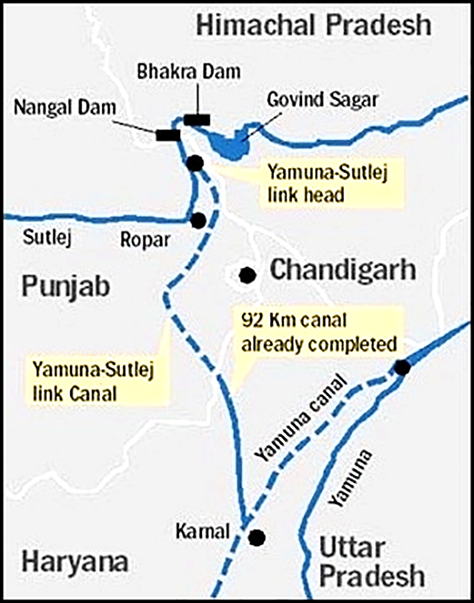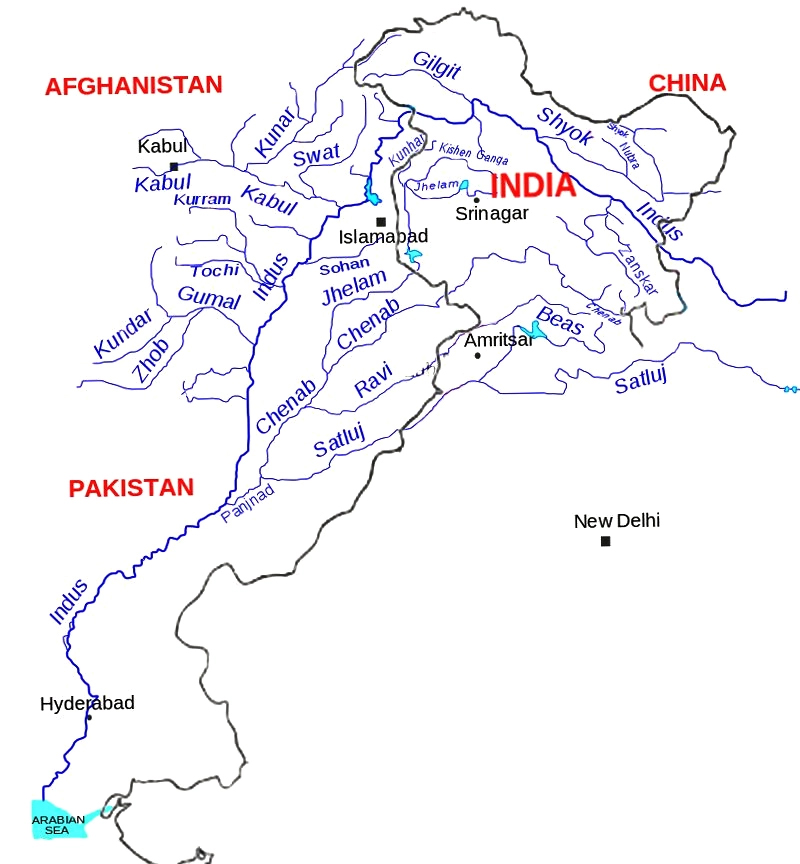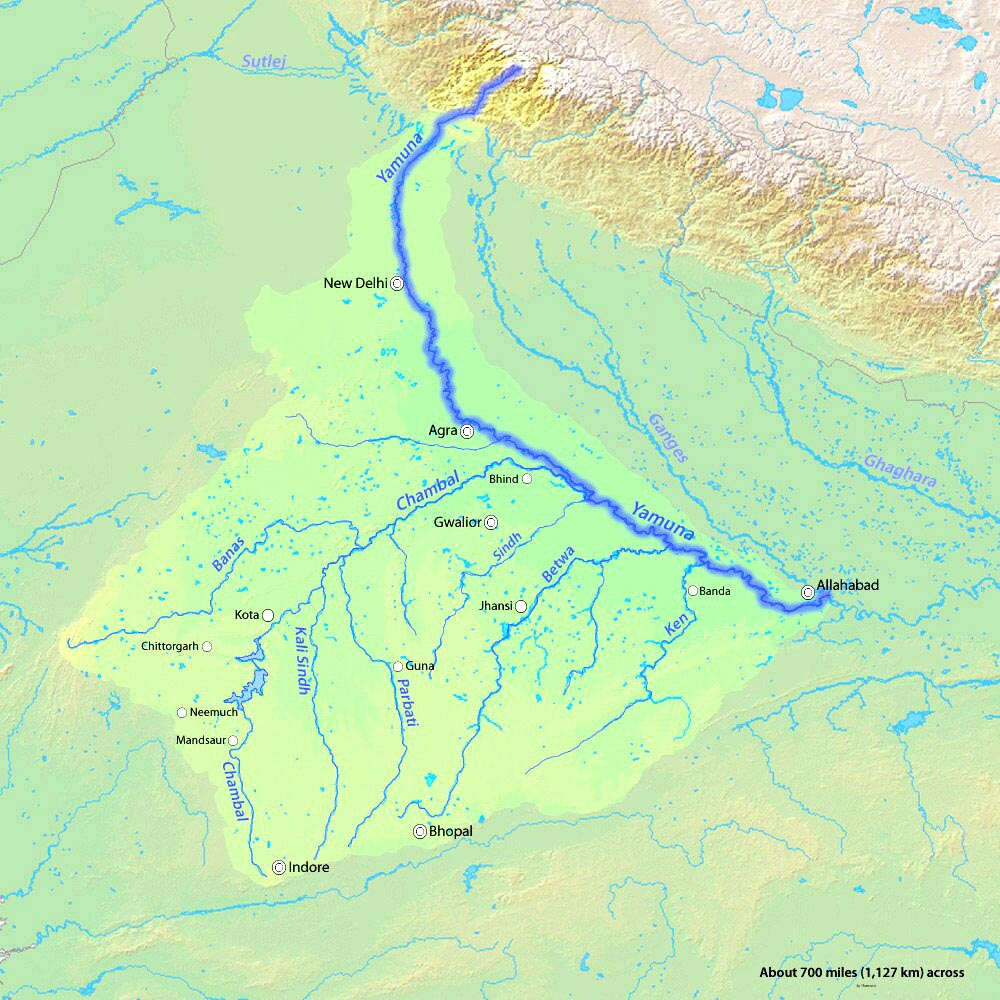Governance
Dispute over Sutlej Yamuna Link (SYL) Canal
- 06 Apr 2022
- 10 min read
For Prelims: Indus Water Treaty, Ravi and Beas, Article 143, Sutlej River, Yamuna River
For Mains: Dispute over Sutlej Yamuna Link Canal (SYL) Canal, Interstate River Water Issue
Why in News?
Recently, the Haryana Vidhan Sabha has passed a resolution seeking completion of the Sutlej Yamuna Link (SYL) Canal.
- The canal, once completed, will enable sharing of the waters of the rivers Ravi and Beas between Haryana and Punjab.
- The Satluj Yamuna Link Canal is a proposed 214-kilometre-long canal connecting Sutlej and Yamuna rivers.
- Water resources are under the State List, while the Parliament has the power to make laws regarding inter-state rivers under the Union List.
What is the Background?
- 1960: The dispute can be traced back to the Indus Water Treaty between India and Pakistan, allowing the former ‘free and unrestricted use’ of Ravi, Beas and Sutlej.
- 1966: Creation of Haryana from the old (undivided) Punjab presented the problem of giving Haryana its share of river waters.
- For Haryana to get its share of the waters of the Sutlej and its tributary Beas, a canal linking the Sutlej with the Yamuna was planned (SYL Canal).
- Punjab refused to share waters with Haryana stating it was against the riparian principle which dictates that the water of a river belongs only to the State and country or States and countries through which the river in question flows.
- 1981: Both states mutually agreed for the re-allocation of water.
- 1982: Construction of 214-km SYL was launched in Kapoori village, Punjab.
- Agitations, protests and assassinations were carried out in protest creating the environment of terrorism in the state and making the issue of national security.
- 1985:
- Prime Minister Rajiv Gandhi and then Akali Dal chief Sant signed an accord agreeing for a new tribunal to assess the water.
- The Eradi Tribunal headed by Supreme Court Judge V Balakrishna Eradi was set up to reassess availability and sharing of water.
- In 1987, the tribunal recommended an increase in the shares of Punjab and Haryana to 5 MAF and 3.83 MAF, respectively.
- 1996: Haryana moved the Supreme Court (SC) seeking directions to Punjab to complete the work on the SYL.
- 2002 and 2004: SC directed Punjab to complete the work in its territory.
- 2004: Punjab Assembly passed the Punjab Termination of Agreements Act, terminating its water-sharing agreements and thus jeopardising the construction of SYL in Punjab.
- 2016: SC started hearings into a presidential reference (Article 143) to decide on the legality of the 2004 Act and declared that Punjab backed out of its promise to share the waters of rivers. Thus, the act was termed constitutionally invalid.
- 2020:
- SC directed the Chief Ministers of both states to negotiate and settle the SYL canal issue at the highest political level to be mediated by the Centre.
- Punjab has asked for a tribunal for fresh time-bound assessment of the water availability.
- Punjab holds that there has been no adjudication or scientific assessment of river waters in the state till date.
- The availability of Ravi-Beas water has also come down from the estimated 17.17 MAF in 1981 to 13.38 MAF in 2013. A fresh tribunal would ascertain all this.
What is the Argument of Punjab and Haryana?
- Punjab:
- Many areas in Punjab may go dry after 2029 and the state has already over-exploited its groundwater for irrigation purposes as it fills granaries of the Centre by growing wheat and paddy worth Rs 70,000 crore every year.
- Water in about 79% of the state’s area is over-exploited and in such a situation, the government says sharing water with any other state is impossible.
- Many areas in Punjab may go dry after 2029 and the state has already over-exploited its groundwater for irrigation purposes as it fills granaries of the Centre by growing wheat and paddy worth Rs 70,000 crore every year.
- Haryana:
- It says that providing irrigation is tough for the state and there was a problem of drinking water in southern parts of Haryana, where groundwater has depleted up to 1,700 feet.
- Haryana has been citing its contribution to the central food pool and arguing that it is being denied its rightful share in the water as assessed by a tribunal.
What are the Key Highlights about Sutlej and Yamuna River?
- Sutlej:
- The ancient name of Sutlej River is Zaradros (Ancient Greek) Shutudri or Shatadru (Sanskrit).
- It is the longest of the five tributaries of the Indus River that give the Punjab (meaning “Five Rivers”) its name.
- Jhelum, Chenab, Ravi, Beas and Satluj are main tributaries of Indus.
- It rises on the north slope of the Himalayas in Lake La’nga in southwestern Tibet.
- Flowing northwestward and then west-southwestward through Himalayan gorges, it enters and crosses Himachal Pradesh before beginning its flow through the Punjab plain near Nangal.
- Continuing southwestward in a broad channel, it receives the Beas River (and forms 65 miles of the India-Pakistan border before entering Pakistan and flowing another 220 miles to join the Chenab River west of Bahawalpur.
- Sutlej River meets the Beas River in Harike in the Ferozpur district before entering Pakistan.
- The combined rivers then form the Panjnad, the link between the Five Rivers and the Indus.
- Luhri Stage-I Hydro Electric Project is located on River Satluj in Shimla and Kullu districts of Himachal Pradesh.
- Yamuna:
- Source: The river Yamuna, a major tributary of river Ganges, originates from the Yamunotri glacier near Bandarpoonch peaks in the Mussoorie range of the lower Himalayas at an elevation of about 6387 meters above mean sea level in Uttarkashi district of Uttarakhand.
- Basin: It meets the Ganges at the Sangam (where Kumbh mela is held) in Prayagraj, Uttar Pradesh after flowing through Uttarakhand, Himachal Pradesh, Haryana and Delhi.
- Length: 1376 km
- Important Dam: Lakhwar-Vyasi Dam (Uttarakhand), Tajewala Barrage Dam (Haryana) etc.
- Important Tributaries: Chambal, Sindh, Betwa and Ken.
Way Forward
- The water disputes can be solved or balanced by having a permanent tribunal established with appellate jurisdiction of the Supreme Court established over the tribunal’s decision.
- The immediate target of any Constitutional Government should be amendment to Article 262 (Adjudication of disputes relating to waters of inter State rivers or river valleys) and amendment to Inter-State Water Disputes Act and its implementation at the equal note.
UPSC Civil Services Examination, Previous Year Questions (PYQs):
Q. With reference to the Indus river system, of the following four rivers, three of them pour into one of them which joins the Indus directly. Among the following, which one is such a river that joins the Indus direct?
(a) Chenab
(b) Jhelum
(c) Ravi
(d) Sutlej
Ans: (d)
- The Jhelum joins the Chenab near Jhang in Pakistan.
- The Ravi joins the Chenab near Sarai Sidhu.
- Satluj is joined by the Chenab in Pakistan. Thus, Satluj receives the collective drainage of the Ravi, Chenab and Jhelum rivers. It joins the Indus a few kilometres above Mithankot.
Q. Consider the following pairs: (2014)
Wetlands Confluence of rivers
- Harike Wetlands : Confluence of Beas and Satluj/Sutlej
- Keoladeo Ghana : Confluence of Banas National Park and Chambal
- Kolleru Lake : Confluence of Musi and Krishna
Which of the above pairs is/are correctly matched?
(a) 1 only
(b) 2 and 3 only
(c) 1 and 3 only
(d) 1, 2 and 3
Ans: (a)
- Harike is one of the largest man-made wetlands of Northern India. It came into existence in 1952 after the construction of barrage near the confluence of rivers Satluj and Beas.
- It was accorded the wetland status in 1990 under the Ramsar Convention.
- Keoladeo National Park is situated at the confluence of the Gambhir and Banganga rivers in the Bharatpur district of Rajasthan.
- Kolleru Lake is located between Krishna and Godavari deltas. Kolleru spreads into two districts – Krishna and West Godavari.







